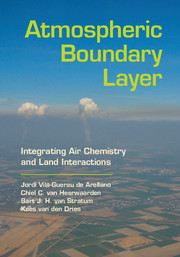Book contents
- Frontmatter
- Contents
- CLASS Software
- Preface
- Acknowledgments
- Part I The Land-Atmospheric Boundary Layer System
- Part II The Uncoupled System
- Part III The Coupled System
- 9 Atmosphere-Vegetation-Soil Interaction
- 10 Numerical Experiments: Atmosphere-Vegetation-Soil Interaction
- 11 A Dynamic Representation of Carbon Dioxide Exchange from the Vegetation and Soil
- 12 Sensitivity of the Atmosphere-Vegetation-Soil System to Climate Perturbations
- 13 Case Studies of More Complex Situations
- Part IV Processes Related to Boundary Layer Clouds
- Part V User's Guide: CLASS Modules and Variables
- Appendices
- Bibliography
- Index
9 - Atmosphere-Vegetation-Soil Interaction
from Part III - The Coupled System
Published online by Cambridge University Press: 05 July 2015
- Frontmatter
- Contents
- CLASS Software
- Preface
- Acknowledgments
- Part I The Land-Atmospheric Boundary Layer System
- Part II The Uncoupled System
- Part III The Coupled System
- 9 Atmosphere-Vegetation-Soil Interaction
- 10 Numerical Experiments: Atmosphere-Vegetation-Soil Interaction
- 11 A Dynamic Representation of Carbon Dioxide Exchange from the Vegetation and Soil
- 12 Sensitivity of the Atmosphere-Vegetation-Soil System to Climate Perturbations
- 13 Case Studies of More Complex Situations
- Part IV Processes Related to Boundary Layer Clouds
- Part V User's Guide: CLASS Modules and Variables
- Appendices
- Bibliography
- Index
Summary
How do the conditions of the vegetation and soil influence the atmospheric boundary layer characteristics? In turn, are the atmospheric variables affecting the exchange of water and carbon dioxide at the surface? In the following chapters, we study the relations and feedbacks in the atmosphere-vegetation-soil system. We begin by explaining the radiation budget, the essential driver that puts energy into the system. Subsequently, we describe how this available energy is partitioned in sensible (heat) and latent (moisture) turbulent fluxes forming important components of the surface energy balance. In the first instance, we omit the explicit response of plants to focus on the essential components that determine the land-atmosphere interaction on the potential temperature and moisture budget. In Chapter 11, we introduce the reader to a conceptual description of a plant physiology model that allows a response of the plant to atmosphere conditions. In so doing, we are able to investigate the coupling between the exchange of water and carbon dioxide, and the boundary layer dynamics and cloud formation.
Radiation and Energy Balance
The amount of energy in the atmosphere is determined by the shortwave solar radiation and by the longwave radiation, which, in turn, is determined by the properties of the land surface and the clouds. The essential exchange between the radiative and turbulent energy takes place on the Earth's surface; that means that soil properties and vegetation conditions are the principal players in this interchange. In order to describe the land-atmosphere system, we divide the system into five components: radiation, soil/vegetation dynamics, atmospheric surface layer dynamics, atmosphere boundary layer dynamics, residual layer/free atmosphere characteristics.
We begin by providing a brief explanation of the basic principles related to the radiation and energy budgets. We then describe and explain the mathematical representation of the land surface system, thus completing the atmospheric mixed-layer framework used to study the potential temperature and moisture budgets.
- Type
- Chapter
- Information
- Atmospheric Boundary LayerIntegrating Air Chemistry and Land Interactions, pp. 113 - 125Publisher: Cambridge University PressPrint publication year: 2015



